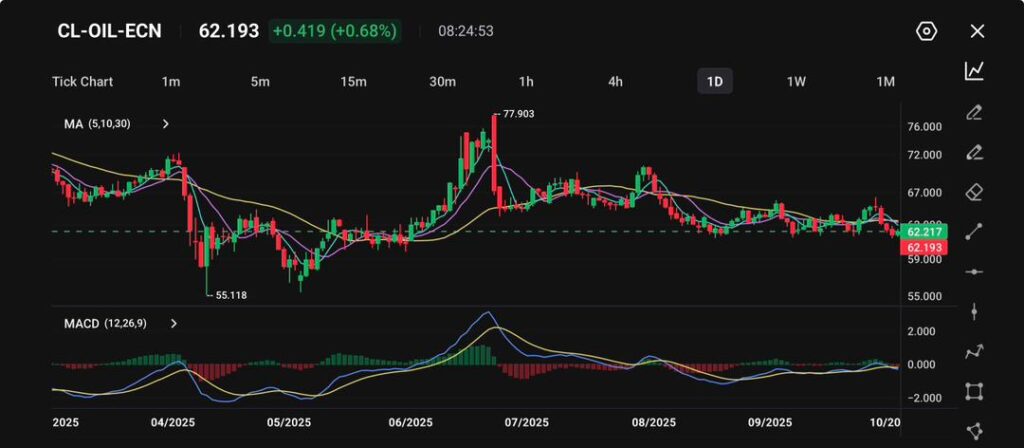
Key Points
- WTI rose 0.55% to $62.12, while Brent gained 0.57% to $65.72.
- Supply risks from tighter Russian sanctions and Chinese demand lent support.
Oil prices climbed on Thursday after three consecutive sessions of losses, with traders citing technical support and renewed geopolitical risks. West Texas Intermediate (WTI) futures advanced 34 cents, or 0.55%, to $62.12 per barrel, while Brent crude rose 37 cents, or 0.57%, to $65.72.
The uptick came as WTI approached its $60 support level, prompting a wave of buying interest. Analysts also pointed to the potential for tighter sanctions on Russian crude, which could restrict supply and lend stability to prices.
The Group of Seven finance ministers pledged to intensify pressure on Moscow by targeting buyers of Russian oil and those facilitating sanction circumvention.
This came alongside reports that Washington will provide Ukraine with intelligence to support long-range missile strikes on Russian refineries, pipelines, and other energy infrastructure, potentially disrupting the Kremlin’s oil revenues.
China’s stockpiling of crude, as the world’s largest importer, added further support by cushioning against the downside.
However, market sentiment remained capped by concerns over a looming U.S. government shutdown and the prospect of higher OPEC+ output.
Sources familiar with the bloc’s discussions suggested that producers could raise supply by up to 500,000 barrels per day in November, triple October’s increase. This comes on the back of Saudi Arabia seeking to defend its market share.
Meanwhile, U.S. Energy Information Administration data highlighted softer demand. Crude inventories rose by 1.8 million barrels last week to 416.5 million, compared with forecasts for a 1 million-barrel increase. Gasoline and distillate stockpiles also expanded as refining activity slowed.
Technical Analysis
Crude oil (CL-OIL) is trading at 62.19, up 0.68% on the day, staging a modest rebound after recent weakness. Despite today’s uptick, the broader picture still shows oil under pressure, with prices struggling to sustain momentum above the 65–67 resistance zone and trending sideways since the sharp drop from the July peak at 77.90.
From a technical perspective, oil remains in a consolidation range, with the 5-, 10-, and 30-day moving averages clustered closely, reflecting indecision in the market. Support continues to hold around 59.00–60.00, which has acted as a base since mid-September. Any decisive break below that region would risk a deeper correction toward the 55.00 low from April.

The MACD remains muted, hovering near the zero line, with a slight uptick in histogram bars showing some early bullish momentum. However, the lack of strong divergence suggests buyers are hesitant to commit.
For now, the outlook remains neutral to mildly bearish. If prices can reclaim and hold above 65.00, it could spark a recovery toward 70.00. Conversely, failure to stay above 60.00 would open the door to further downside.
Traders should watch for external catalysts such as inventory reports, OPEC+ commentary, or geopolitical headlines, which could provide the volatility needed to break oil out of this holding pattern.









